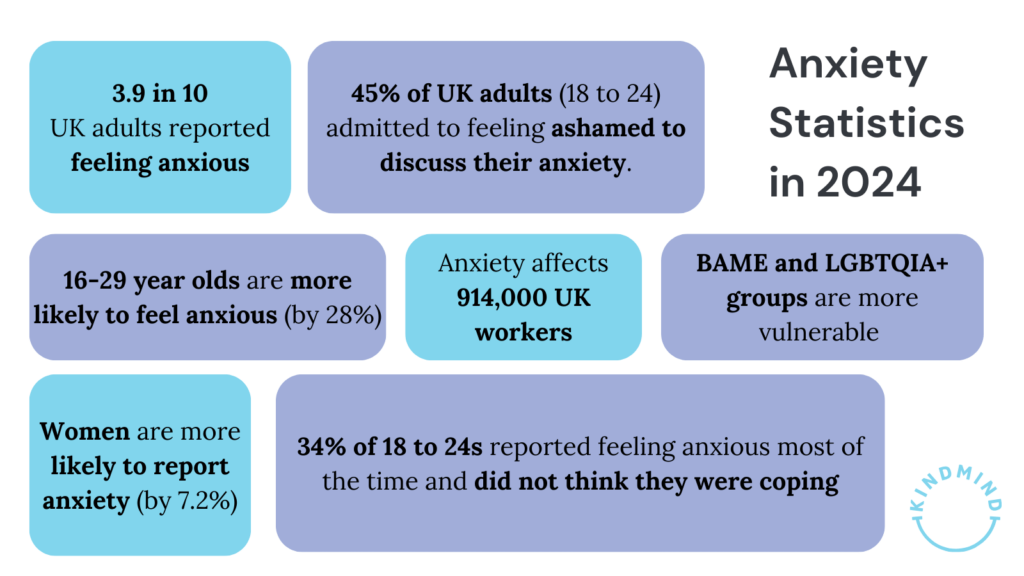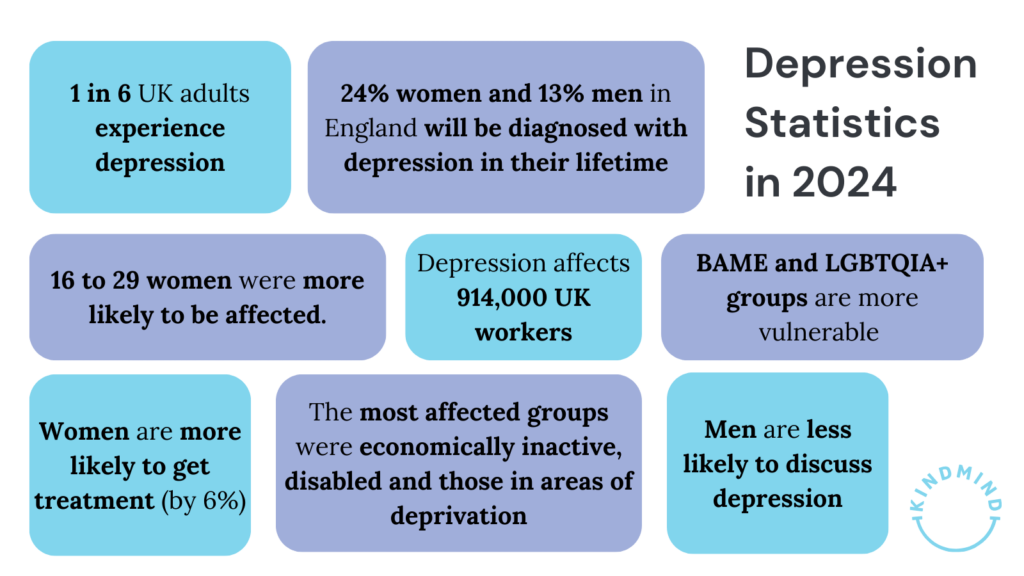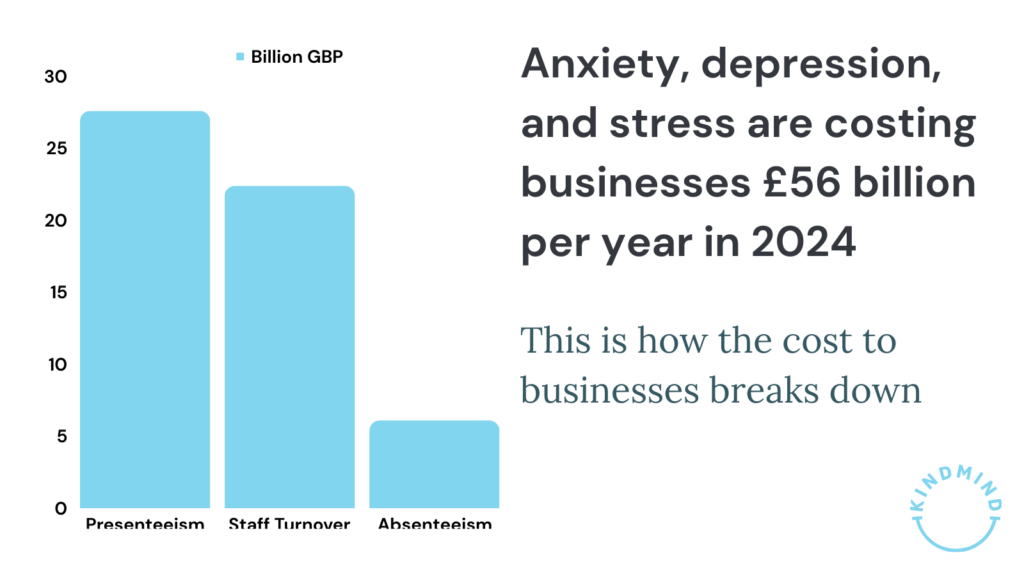2024 Mental Health Statistics: A focus on anxiety, stress and depression, UK edition
Welcome to our research into mental health statistics for 2024!
Much of our work here at Kind Mind is about education – helping employers understand how their staff cope and manage their mental, emotional and physical health. It’s also about educating and supporting staff to recognise and react accordingly to triggers that affect their well-being.
We base our work on science – the statistical data of studies into wellness. It makes sense to share this particular research with you because we think there’s a benefit in the conversation.
So here it is, our state of mental health in 2024, with a particular focus on anxiety, depression and stress and their effects on UK business.
The state of mental health in the UK
Anxiety, stress and depression are three of the UK’s most commonly diagnosed mental health disorders among younger generations, primarily women and also BAME or LGBTQIA+ groups. But that’s not the whole story; men are also suffering from increased mental health problems, although they seem far less likely to talk about them. Worrying still is the rise of reported cases where our well-being is affecting our ability to work.
But what does that look like in real terms? What mental health statistics can we cite to back up our claims? Let’s have a look.
Anxiety statistics
Anxiety is an emotional response triggered by prolonged and sometimes unexplained tension or worry that results in physical and emotional reactions. Anxious symptoms include:
- Increased blood pressure
- Rapid breathing
- Sweating
- Trembling
- A lack of concentration
- Extreme exhaustion
- A prolonged feeling of guilt or unworthiness
It is an emotion we all struggle with. Still, the reactions are severe enough for some to result in a medical diagnosis.

Here are the proven mental health statistics about the anxiety levels of people in the UK going into 2024.
- Younger people aged 16-29 are 28% more likely to experience anxiety. [1 – Office of National Statistics]
- Across all age ranges, the likelihood of reporting anxiety is more prevalent among women (at a rate of 37.1%) than men (29.9%). [2 – Office of National Statistics]
- In that same study, updated in October 2023, 3.9 in 10 UK adults reported feeling anxious.
- 41.49% of people reporting anxiety are experiencing medium to high-level reactions. [3 – Office of National Statistics]
- 45% of UK adults between 18 and 24 admitted to feeling ashamed to discuss their anxiety. [4 – Mental Health Foundation]
- In that same report, a survey of 6,000, 34% of people aged 18 to 24 reported feeling anxious most of the time and did not think they were coping.
- For most younger people, school, college and university success are a big trigger in anxiety, but work also gets a mention. 914,000 UK workers suffer from work-related stress, anxiety and depression. [5 – HSE]
- BAME and LGBTQIA+ groups are more vulnerable groups. [6 – Mental Health Foundation and 7 – Mental Health UK]
Let’s move on from anxiety statistics and look at depression.
Depression statistics
Depression is a mood disorder. At lower levels, you will feel a low mood for weeks or even months, triggering feelings of guilt or low-self worth. While at its most severe, you can feel a sense of hopelessness that can even trigger suicidal thoughts. Depressive symptoms can include:
- Losing sleep while continually exhausted
- Losing appetite and libido
- Body aches and pains
- An inability to concentrate
- A lack of clarity about relationships
- Spiralling mood and apathy

Here are the proven mental health statistics about depression in the UK going into 2024.
- It is thought that 24% of women and 13% of men in England will be diagnosed with depression in their lifetime [9]
- 1 in 6 UK adults experienced some form of depression in 2022. [8 – Office of National Statistics] In line with a study from 2021, which looked at rises in depression triggered by the Pandemic.
- The same study showed that the most affected groups were economically inactive, disabled and those in areas of deprivation. [8]
- Younger women between 16 and 29 were more likely to be affected. [8]
- Women (15%) are more likely to receive treatment than men (9%). [9 – Lubian et al acedemic study]
- Men are unlikely to talk about mental health issues because of negative stigma and feelings of embarrassment. [10 – Priory Group]
- BAME and LGBTQIA+ groups remain more vulnerable groups. [6 and 7]
- 914,000 UK workers suffer from work-related stress, anxiety and depression. [5]
Let’s move on from depression statistics and look at stress.
Stress statistics
The phrases ‘stress’ and ‘anxiety’ are often used interchangeably, but there is a real difference. Anxiety is the persistent feeling of fear and worry, often unrelated to a situation or cause. Stress, on the other hand, is a physical and emotional response to a state of worry or pressure caused by a challenging situation. A situational example of stress is the feeling of worry or pressure before you go into an exam – you usually find this weighted emotion, and its physical effects lift after you exit the exam room.
Common stress reactions include:
- Loss of focus and effectiveness
- Increase in negative mindsets and emotions
- Restlessness
- Increase in worrying dreams or nightmares
- Increased blood pressure
- Tension, headaches, joint aches, stomach problems and nausea

Here are the proven mental health statistics about stress in the UK going into 2024.
- According to one study, 23% of UK adults cite their stress as work-related. [11 – CIPHR]
- But the most significant stress triggers by far were money (39%), not enough sleep (39%), health (35%), family (31%) and the news (24%). [11]
- 66% of 18 to 24-year-olds report suffering from severe forms of stress around the world [12 – Statistica]. Similar to the UK’s last study in 2018, which reported a statistic of 60% among the same age group [13 – Mental Health Foundation].
- Working women between 35-44 who are juggling work and motherhood are 50% more likely to suffer stress than men of the same age. [14 – Priory Group]
- While men are much less likely to talk about feelings of stress and even less likely to report work-related stress to a manager – a worldwide phenomenon. [15 – Nick Boettcher et al.]
- In this category, BAME and LGBTQIA+ groups are more vulnerable groups. [6 and 7]
- 914,000 UK workers suffer from work-related stress, anxiety and depression. [5]
Let’s move on from stress statistics and look at possible triggers for poor mental health.
What is triggering these mental health statistics in the UK?
While for many, the COVID-19 pandemic is something we have moved on from, the effects of isolation and loneliness are still being realised. As a nation, we are also dealing with other social, economic and financial pain points.
We’ve seen a massive rise in inflation, which triggered a cost-of-living and housing and renters crises. Wages no longer cover the essentials of primary stability for many.
The war in Ukraine triggered gas price hikes, which compounded financial worries for UK residents but also presented a threat of a widening conflict (including a global nuclear threat). Add to this the Hamas attack on Israel, which has renewed conflict in the Gaza region, Iran’s anti-regime protests, Africa, Haiti, Pakistan, and Taiwan, and suddenly you feel stressed watching the news.
We are also experiencing a shift in social opinion about our politics and the governing party, leading to uncertainty in its effectiveness in delivering the needed help. At work, as a consequence, we feel more pressured than ever to succeed and to hold onto our jobs and our pay.
Socially, we are feeling more mental pressure, with social media and cyberbullying starting at younger and younger ages [16 – Anti-bullying Alliance] and cybercrime at 33% higher than in 2022 [17 – Office for National Statistics]. Crime is also rising in our streets, up 4% in 2023 [17]. Robbery, knife crime, and vehicle-related theft are growing concerns.
We are also worried about climate. As patterns show dramatic increases in extreme weather events, 64% of UK adults said that in the past 12 months, they had been concerned about the impact of climate change [18 – Office for National Statistics].
Are we more open to discussing anxiety, depression and stress in the UK?
As a society, we seem more open to discussing mental health statistics these days, which may account for why we are seeing higher levels of mental health awareness and diagnosis. However, it is clear this is not enough, especially among men and in vulnerable groups.
Coupled with the growing pressures on the NHS and long wait times, it’s unlikely we are seeing the complete state of mental health in the UK. It is clear – We must provide more mental health support, resources and safe spaces for people to open up.
The cost to business of anxiety, depression and stress.
The average worker works 35-40 hours per week in the UK [19 – Statistica], so it’s fair to assume that anxiety, depression and stress, whether triggered by work (affecting almost a quarter of our staff [11]) or outside of work, will spill into the workplace.
It will affect our employees’ ability to produce consistently high-quality work, to focus on learning and excelling at new tasks, and to creatively approach new projects.

In cost terms, the effects of these mental health statistics in the UK can be seen as:
- 18.6 workdays per year per employee are lost due to anxiety, depression and stress [20 – Health and Safety Executive]
- Costing businesses £56 billion per year, an increase from £45 billion in 2019, which is a staggering rise of 25% [21 – Deloitte]

These costs aren’t just singular events of absence but an increase in:
- Presenteeism which costs between £24.8 and £27.6 billion per year [22 – Deloitte]
- Staff turnover costs of £22.4 billion per year [22]
- And absenteeism costs at £6.1 billion per year [22]
There is also a cost to our customers and our business reputation. Less staff means a lower standard of customer service, as seen by longer query-to-solution journeys. Less ‘focused’ staff represents a higher likelihood of discrepancies. Unhappy staff often translates into a less satisfying customer experience. Don’t believe us? Read our guide, “How a happy employee experience impacts customer experience.“
Wrapping up mental health statistics for 2024
Laid bare, these statistics are clear – there’s more work to be done in recognising and supporting friends, family and staff. It’s also about recognising and seeking support for our own mental health. And it starts with a conversation.
At Kind Mind, we are always open to conversations about mental health awareness and well-being. Follow us on LinkedIn and have your say.
References
[1] Office of National Statistics, 20th October 2021, depression or anxiety in adults, Great Britain: 22nd September to 3rd October 2021
[2] Office of National Statistics, 20th October 2023, Public opinions and social trends, Great Britain: personal well-being and loneliness, 4 to 15th October 2023 figures
[3] Office of National Statistics, 11th August 2023, Quarterly personal well-being estimates – seasonally adjusted, Jan to March 2023 figures
[4] Mental Health Foundation, 17th May 2023, Young people aged 18 to 24 are the age group most likely to feel anxious in the UK, according to our recent survey
[5] Health and Safety Executive, Health and safety statistics: Key figures for Great Britain (2021/22)
[6] Mental Health Foundation, Black, Asian and minority ethnic (BAME) communities
[7] Mental Health UK, LGBTQIA+ people’s mental health
[8] Office of National Statistics, 6th December 2022, cost of living and depression in adults, Great Britain: 29th September to 23rd October 2022
[9] Lubian, K; Weich, S; Stansfield, S; Bebbington, P; Brugha, T; Spiers, N; McManus, S, (2016) Chapter 3: Mental health treatment and services. In: McManus, S and Bebbington, P and Jenkins, R and Brugha, T, (eds.), Mental health and well-being in England: Adult Psychiatric Morbidity Survey 2014. (p. 69). NHS Digital: Leeds, UK. 2014.
[10] Priory Group, Men’s Mental Health: 40% Of Men Won’t Talk About Their Mental Health
[11] CIPHR, Workplace stress statistics in the UK
[12] Statistica, February 2023, Percentage of individuals worldwide reporting moderate to severe symptoms of stress, depression, and anxiety in 2022, by age group
[13] Mental Health Foundation, 2018 study, Stress: Are we coping?
[14] Priory Group, Why are stress levels among women 50% higher than men?
[15] Nick Boettcher, Jennifer Mitchell, Bonnie Lashewicz, Erin Jones, JianLi Wang, Sarika Gundu, Alain Marchand, Erin Michalak, and Ray Lam, 17th March 2019, Men’s Work-Related Stress and Mental Health: Illustrating the Workings of Masculine Role Norms, American Journal of Men’s Health, 2019 Mar-Apr edition 13(2). Published online by the National Library of Medicine.
[16] Anti-bullying Alliance, Prevalence of online bullying
[17] Office for National Statistics, 19th October 2023, Crime in England and Wales: year ending June 2023
[18] Office for National Statistics, 11th August 2023, Climate change insights, families and households, UK: August 2023
[19] Statistica, 24th October 2024, Average weekly hours of work for full-time workers in the United Kingdom from May 1992 to July 2023
[20] Health and Safety Executive, 2021/22, Working days lost in Great Britain
[21] Deloitte, 1st April 2022, Poor mental health costs UK employers up to £56 billion a year
[22] Deloitte, 2022 Report (PDF), Mental health and employers: The case for investment – Pandemic and beyond






